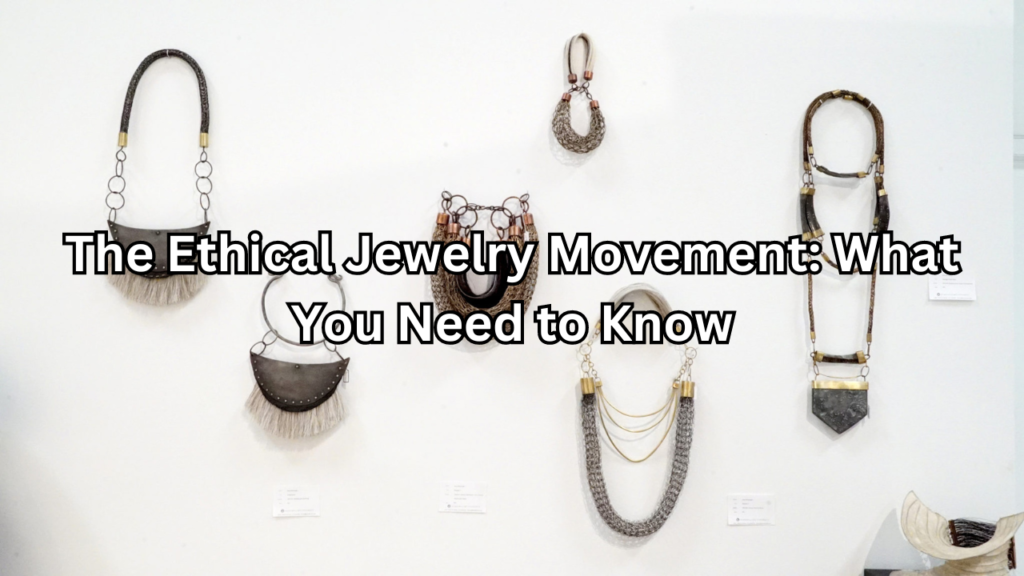

Table of Contents
Introduction
In recent years, the jewelry industry has faced increasing scrutiny over its impact on the environment and human rights. As consumers become more conscious of the ethical implications of their purchases, the rise of the ethical jewelry movement has emerged as a beacon of change. This movement advocates for jewelry that not only dazzles but also aligns with values of sustainability, fairness, and transparency. As the demand for ethical practices in every facet of life grows, the jewelry sector is transforming to meet these new expectations, challenging traditional norms and setting new standards for responsible luxury.
Brief Overview of the Ethical Jewelry Movement
The ethical jewelry movement represents a significant shift in how jewelry is sourced, produced, and consumed. At its core, this movement seeks to address and rectify the negative consequences often associated with traditional jewelry practices. Key aspects include the use of conflict-free and recycled materials, fair trade practices, and a commitment to reducing environmental impact. Brands within this movement prioritize transparency, ensuring that every step of the supply chain is scrutinized to uphold ethical standards. This shift is not just a trend but a necessary evolution in response to growing awareness of the social and environmental ramifications of jewelry production.
Importance of Ethical Considerations in the Jewelry Industry
The jewelry industry has long been marred by issues such as environmental degradation, exploitative labor practices, and the trade of conflict minerals. Mining operations for precious metals and gemstones often result in significant ecological damage, including deforestation and soil erosion. Moreover, labor conditions in many mining regions can be harsh, with workers facing dangerous conditions and inadequate wages. The ethical jewelry movement addresses these critical issues by promoting practices that mitigate harm and support positive social and environmental outcomes. By prioritizing ethical considerations, the movement helps ensure that consumers can enjoy their jewelry with the confidence that it has been produced responsibly and fairly.
What is Ethical Jewelry?
Definition and Core Principles
Ethical jewelry is defined by its commitment to ensuring that every aspect of its production aligns with principles of sustainability, fairness, and transparency. At its core, ethical jewelry prioritizes the following key principles:
- Sustainable Sourcing: Ethical jewelry is crafted from materials that are sourced in ways that minimize environmental impact. This includes using recycled metals, lab-grown gemstones, and conflict-free diamonds. The goal is to reduce the ecological footprint of jewelry production and promote the responsible management of natural resources.
- Fair Trade Practices: Ensuring that workers involved in the jewelry supply chain are treated fairly is a cornerstone of ethical jewelry. This involves adhering to fair trade principles, which include providing safe working conditions, fair wages, and the right to collective bargaining. Ethical jewelry brands often work with suppliers who are certified by fair trade organizations or who demonstrate a commitment to ethical labor practices.
- Transparency: Ethical jewelry brands emphasize transparency in their supply chains. This means providing clear information about where materials are sourced, how they are processed, and the practices of their suppliers. Transparency helps consumers make informed choices and ensures that brands are accountable for their environmental and social impact.
Differences Between Ethical and Traditional Jewelry
While traditional jewelry and ethical jewelry may appear similar on the surface, there are fundamental differences in their underlying practices:
- Material Sourcing: Traditional jewelry often relies on mined gemstones and metals, which can contribute to environmental degradation and ethical concerns such as conflict mining and exploitative labor conditions. Ethical jewelry, on the other hand, uses materials that are sourced responsibly. This includes recycled materials, lab-grown alternatives, and certified conflict-free stones.
- Environmental Impact: Traditional jewelry production can result in significant ecological damage, including habitat destruction, pollution, and resource depletion. Ethical jewelry brands actively work to minimize their environmental footprint by adopting sustainable practices and supporting eco-friendly initiatives.
- Labor Practices: The traditional jewelry industry has faced criticism for poor labor conditions, including unsafe working environments and inadequate wages. Ethical jewelry brands prioritize fair labor practices, ensuring that workers are treated with respect and paid fairly. This often involves working with suppliers who adhere to strict labor standards and certifications.
- Transparency and Accountability: Traditional jewelry brands may lack transparency about their supply chains and production processes. Ethical jewelry brands, however, are committed to openness, providing detailed information about their sourcing, manufacturing practices, and efforts to ensure ethical standards are met.
By understanding these distinctions, consumers can make more informed choices and support jewelry that aligns with their values.
The History of Ethical Jewelry
Evolution of Ethical Practices in the Jewelry Industry
The ethical jewelry movement began gaining traction in the late 20th and early 21st centuries as awareness grew about the environmental and social issues associated with traditional jewelry production. The shift toward ethical practices was driven by increasing consumer demand for transparency and responsibility in the products they purchase. Initially, the movement focused on addressing the glaring issues of conflict diamonds and unethical labor practices. Over time, it has evolved to encompass a broader range of concerns, including sustainable sourcing, eco-friendly production methods, and fair trade principles.
Key milestones in the evolution of ethical jewelry include the introduction of the Kimberley Process Certification Scheme in 2003, aimed at preventing the trade of conflict diamonds. This was a significant step in addressing the ethical issues associated with gemstone sourcing. Additionally, the rise of certifications such as Fair Trade and the establishment of organizations like the Responsible Jewellery Council (RJC) have played crucial roles in promoting ethical standards and practices within the industry.
Key Milestones and Influential Figures
The ethical jewelry movement has been shaped by several influential figures and organizations. One notable figure is Vanessa Friedman, a leading advocate for ethical fashion and jewelry, whose work has brought significant attention to the industry’s ethical issues. Organizations like Fair Trade International and The Kimberley Process have also been instrumental in setting standards and promoting ethical practices.
The launch of Patagonia’s Responsible Sourcing Initiative and the establishment of The Ethical Metalsmiths organization further advanced the movement by pushing for greater transparency and sustainability. These milestones reflect a growing commitment to making the jewelry industry more responsible and aligned with ethical values.
Sourcing and Materials
Ethical Sourcing of Gemstones and Metals
Ethical jewelry prioritizes the responsible sourcing of gemstones and metals to ensure that the materials used are obtained in a manner that supports environmental sustainability and human rights. Gemstones are often sourced from mines that adhere to ethical practices or are replaced with lab-grown alternatives that offer a sustainable solution without the environmental and social drawbacks of traditional mining.
Metals, such as gold and silver, are increasingly sourced from recycled materials or mines that implement rigorous environmental and labor standards. Recycled metals significantly reduce the need for new mining, minimizing environmental impact and conserving natural resources.
Importance of Conflict-Free Diamonds and Fair-Trade Gold
Conflict-free diamonds are crucial in the ethical jewelry movement, as they are certified to be free from financing armed conflicts and human rights abuses. The Kimberley Process Certification Scheme plays a vital role in ensuring that diamonds are sourced ethically, but the movement continues to push for greater transparency and improvements in this certification process.
Fair-trade gold is another significant component, as it guarantees that gold is mined under conditions that respect both people and the environment. Fair-trade gold certification ensures fair wages, safe working conditions, and environmentally friendly mining practices, setting a standard for ethical and responsible gold sourcing.
Environmental Impact
Eco-Friendly Mining Practices
Women Eco-friendly mining practices aim to minimize the environmental impact of extracting minerals and gemstones. This includes adopting methods that reduce soil erosion, water pollution, and habitat destruction. Sustainable mining practices also involve restoring mined land to its natural state and reducing energy consumption through innovative technologies and processes.
Recycling and Sustainable Materials in Jewelry
Recycling plays a crucial role in the ethical jewelry movement by reducing the demand for new raw materials and decreasing the environmental footprint of jewelry production. Recycled metals and gemstones are incorporated into new designs, promoting a circular economy and minimizing waste. Additionally, the use of sustainable materials—such as eco-friendly lab-grown gemstones and ethically sourced materials—helps to reduce the industry’s overall environmental impact and support more responsible production practices.
Fair Trade and Labor Practices
Ensuring Fair Wages and Safe Working Conditions
Fair trade practices in the jewelry industry focus on ensuring that all workers involved in the production process are treated with dignity and respect. This includes providing fair wages that reflect the true value of their labor and enabling them to support their families and communities. Ethical jewelry brands commit to safe working conditions, which involve implementing health and safety measures to protect workers from hazardous environments and ensuring that workplaces adhere to strict safety standards.
Additionally, fair trade practices often involve supporting workers’ rights to organize and advocate for better conditions. This approach fosters a more equitable and supportive working environment, empowering workers to improve their livelihoods and contributing to a more humane and responsible industry.
Impact on Local Communities and Economies
Fair trade practices have a profound impact on local communities and economies. By ensuring fair wages, providing essential equipment, and supporting safe working conditions, ethical jewelry brands contribute to economic stability in mining regions and production areas. This support helps to build infrastructure, fund community projects, and improve the overall quality of life.
Furthermore, fair trade initiatives often invest in education and healthcare programs for workers and their families, creating a ripple effect of positive change. By prioritizing ethical practices, the jewelry industry helps to uplift entire communities, fostering sustainable development and reducing poverty.
Certification and Standards
Overview of Certifications (e.g., Fair Trade, Kimberley Process)
Certifications are crucial in verifying the ethical claims of jewelry brands and ensuring that they adhere to established standards. Some key certifications include:
- Fair Trade Certification: This certification ensures that jewelry is produced under fair labor conditions and that workers receive fair wages. It also guarantees that environmental standards are upheld, and communities benefit from fair trade practices.
- Kimberley Process Certification Scheme: Designed to prevent the trade of conflict diamonds, this certification ensures that diamonds are sourced from regions free of armed conflict and human rights abuses.
- Responsible Jewellery Council (RJC) Certification: This certification verifies that jewelry companies adhere to ethical, social, and environmental standards throughout their supply chain.
How to Verify the Authenticity of Ethical Jewelry
To verify the authenticity of ethical jewelry, consumers should look for certification labels and transparency statements from brands. Reputable ethical jewelry brands often provide information about their certifications and sourcing practices on their websites and product labels. Consumers can also request detailed information about the supply chain and sourcing practices from jewelers to ensure that the jewelry meets their ethical standards. Additionally, checking for third-party reviews and endorsements from independent organizations can help validate the credibility of ethical claims.
Consumer Awareness and Trends
Growing Consumer Demand for Ethical Jewelry
Consumer demand for ethical jewelry has surged as awareness of environmental and social issues in the industry has increased. Shoppers are increasingly seeking out products that align with their values and are willing to invest in jewelry that supports sustainable and ethical practices. This shift is driven by a growing desire for transparency and responsibility, with consumers expecting brands to demonstrate their commitment to ethical standards through their practices and products.
How to Choose and Support Ethical Jewelry Brands
When choosing and supporting ethical jewelry brands, consumers should look for several key indicators:
- Certifications: Verify that the brand holds relevant ethical certifications, such as Fair Trade or Kimberley Process certifications.
- Transparency: Choose brands that are transparent about their sourcing, production processes, and labor practices.
- Reputation: Support brands with a proven track record of ethical practices and positive consumer reviews.
- Story and Values: Consider brands that align with your values and have a clear mission statement related to ethical and sustainable practices.
By making informed choices and supporting ethical jewelry brands, consumers can contribute to a more responsible and sustainable industry while enjoying beautiful, ethically crafted pieces.
Challenges and Criticisms
Common Criticisms of the Ethical Jewelry Movement
While the ethical jewelry movement has made significant strides in promoting sustainability and fairness, it has faced several criticisms:
- Greenwashing: One major criticism is the risk of greenwashing, where brands may present themselves as more ethical than they truly are. This can mislead consumers who are seeking genuine ethical products, as some companies may adopt superficial measures rather than implementing substantial changes.
- High Costs: Ethical jewelry often comes with a higher price tag due to the costs associated with sustainable sourcing, fair labor practices, and certification processes. Critics argue that this can make ethical jewelry less accessible to the average consumer, potentially limiting its broader impact.
- Limited Transparency: Despite the push for transparency, some brands still struggle to provide clear and comprehensive information about their supply chains and practices. This lack of transparency can undermine the credibility of the ethical claims made by these brands.
Ongoing Challenges in Achieving True Ethical Standards
Achieving true ethical standards in the jewelry industry is complex and involves several ongoing challenges:
- Supply Chain Complexity: The jewelry supply chain is often long and intricate, involving multiple stages and actors. Ensuring ethical practices across the entire supply chain, from mining to manufacturing to retail, remains a significant challenge.
- Certification Limitations: While certifications like Fair Trade and Kimberley Process provide important benchmarks, they have limitations. For example, the Kimberley Process has been criticized for its ability to fully prevent the trade of conflict diamonds, and fair trade certifications may not cover all ethical aspects of jewelry production.
- Industry Resistance: Some traditional players in the jewelry industry may resist changes due to entrenched practices and the costs associated with adopting new standards. This resistance can slow the broader adoption of ethical practices across the industry.
The Future of Ethical Jewelry
Emerging Trends and Innovations
The future of ethical jewelry is likely to be shaped by several emerging trends and innovations:
- Technological Advances: Innovations such as lab-grown diamonds and recycled materials are set to become more prevalent. Advances in technology are making it easier and more cost-effective to produce high-quality, sustainable jewelry alternatives.
- Blockchain and Traceability: The use of blockchain technology is being explored to enhance traceability and transparency in the jewelry supply chain. Blockchain can provide immutable records of each stage of the supply chain, ensuring that consumers can verify the ethical origins of their jewelry.
- Eco-Friendly Production: Sustainable production methods, including 3D printing and green chemistry, are being developed to reduce the environmental impact of jewelry manufacturing. These innovations aim to minimize waste and use fewer harmful chemicals.
Predictions for the Evolution of Ethical Practices in the Industry
Looking ahead, the ethical jewelry industry is expected to evolve in several key ways:
- Increased Consumer Demand: As consumer awareness of ethical and environmental issues grows, demand for ethical jewelry is likely to increase. Brands that embrace genuine ethical practices and transparency will be well-positioned to meet this demand.
- Stricter Regulations: Governments and industry organizations may implement stricter regulations and standards to ensure ethical practices in the jewelry sector. This could include more rigorous certification requirements and greater accountability for unethical practices.
- Broader Industry Adoption: Ethical practices are expected to become more widely adopted across the jewelry industry. As more brands commit to sustainable and fair practices, the entire industry may shift toward more responsible production methods, driving positive change on a larger scale.
- Collaborative Efforts: Collaboration between brands, non-governmental organizations, and consumers will play a crucial role in advancing ethical practices. By working together, these stakeholders can address challenges and promote a more sustainable and equitable jewelry industry.
Final Thoughts
As we reflect on the ethical jewelry movement, it’s clear that this transformative shift represents more than just a trend—it embodies a profound commitment to positive change within an industry traditionally fraught with challenges. The movement stands as a testament to the growing recognition of our collective responsibility to both people and the planet. By advocating for sustainable sourcing, fair labor practices, and transparency, ethical jewelry is setting new standards for how we approach luxury and craftsmanship.
The progress made by ethical jewelry brands highlights the power of consumer choices in driving industry-wide change. Each purchase of ethically sourced and produced jewelry not only supports fair wages and safe working conditions but also contributes to reducing environmental degradation and promoting responsible resource management. This ripple effect extends beyond the jewelry itself, fostering a more sustainable and just world.
In choosing ethical jewelry, consumers play a crucial role in shaping the future of the industry. By supporting brands that prioritize ethical practices and transparency, we collectively push for higher standards and greater accountability. This conscious decision-making fosters a culture of responsibility and encourages other sectors to adopt similar values.
Ultimately, the ethical jewelry movement is a powerful reminder that luxury and integrity can coexist. Embracing ethical choices empowers us to make a meaningful impact, ensuring that our appreciation for beauty aligns with our commitment to a more equitable and sustainable future. As this movement continues to evolve, it invites us all to be more mindful of the legacy we leave behind and to celebrate the beauty of jewelry that reflects our shared values of justice and respect.





